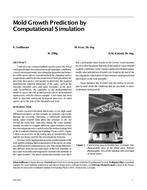
Mold Growth Prediction by Computational Simulation
Until now, the common methods used to assess the risk of mold growth have been based on steady boundary conditions. A newly developed model, describing the hygrothermal behavior of the spore, allows consideration of the changing surface temperatures and RH for the prediction of mold growth for the first time. Research is still needed to determine the required hygrothermal material properties of the spore, such as the moisture retention curve and vapor resistance of the spore wall. Nevertheless, the capability of the biohygrothermal model to assess the risk of mold growth can be demonstrated impressively with the chosen example. A new basis has been built to describe nonsteady biological processes in mold spores, up to the start of the metabolism at least.
Authors:K. Sedlbauer; M. Krus, Dr.-Ing.; W. Zillig; H.M. KÃnzel, Dr.-Ing.
Citation:Indoor Air Quality 2001 Moisture, Microbes, and Heath Effects: Indoor Air Quality and Moisture in Buildings Conference Papers
Keywords:November, California, 2001, IAQ
Citation: IAQ Conference: IAQ 2001
Product Details
- Published:
- 2001
- File Size:
- 1 file , 740 KB
- Product Code(s):
- D-8153


